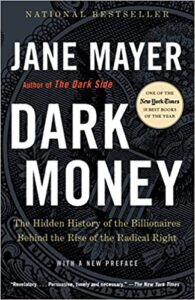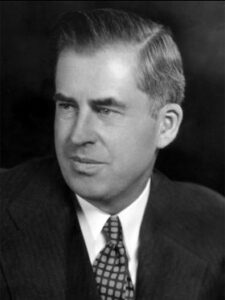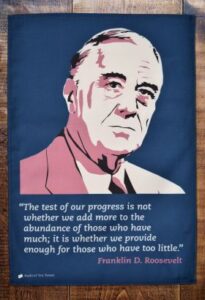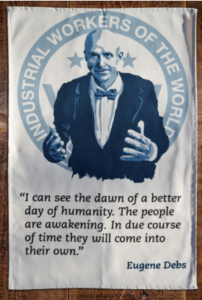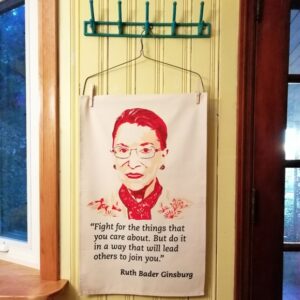#MUSTWATCH
October 13, 2020[U.S. Senator Sheldon Whitehouse, Rhode Island, during Judge Amy Coney Barrett’s nomination hearing to the Supreme Court.]
Grab a cup of tea…might need a cocktail. 28:37. Worth every minute. Brilliant. -Dayle
From New Yorker staff writer Jane Mayer and author of the book, Dark Money:
“Amazing exposition of the dark money behind the Supreme Court fight via Sen. Whitehouse.”
Dark Money:
In the politics of the united States, refers to political spending by nonprofit organizations — for example, 501(c)(4) (social welfare) 501(c)(5)(unions) and 501(c)(6) (trade association) groups — that are not required to disclose their donors. Such organizations can receive unlimited donations from corporations, individuals and unions. In this way, their donors can spend funds to influence elections, without voters knowing where the money came from. Dark money first entered politics with Buckley v. Valeo (1976) when the United States Supreme Court laid out Eight Magic Words that define the difference between electioneering and issue advocacy.
According to the Center for Responsive Politics (CRP), spending by organizations that do not disclose their donors has increased from less than $5.2 million in 2006 to well over $300 million in the 2012 presidential cycle and more than $174 million in the 2014 midterms.” The New York Times editorial board has opined that the 2014 midterm elections were influenced by “the greatest wave of secret, special-interest money ever raised in a congressional election.”CRP also noted that the 2010 landmark case, Citizens United v. FEC, marked the turning point when dark money contributions surged, stating “there are other groups now free to spend unrestricted funds advocating the election or defeat of candidates. These groups contend that they are not required to register with the FEC as any sort of PAC because their primary purpose is something other than electoral politics. This spending itself isn’t new. But the use of funds from a virtually unrestricted range of sources, including corporations, began with the most recent court rulings.” [wikipedia]
The greatest president we never had.
Henry Wallace
(Picture: Wikimedia Commons)
One of the very best almost-presidents was Henry Wallace (1888-1965) – and he came much, much closer than most.
‘Born into a wealthy Iowa farming family, Wallace hadn’t had the working-class background of a Bernie Sanders or Alexandra Ocasio-Cortez. But he certainly had the political instinct for compassion and social justice.
During the 1920s, he rose to prominence lobbying for federal relief to poor farmers which was consistently denied by the traditionally progressive Republican Party.
This led him, in 1932, to switch over to the Democratic Party of Franklin Roosevelt, which was promising America a New Deal in the wake of the Wall Street Crash.
Thankfully, Roosevelt won and he made Wallace his Secretary of Agriculture.
In 1940, after years of steadfast support for FDR’s New Deal, Roosevelt chose Wallace to be his new running mate. Wallace then served four years as Vice-President of the United States from 1941-5.
Henry Wallace was one of the most progressive members of Roosevelt’s administration.’
‘Championing economic democracy and internationalism, he said,
“Some have spoken of the ‘American Century’. I say that the century on which we are entering – the century which will come into being after this war – can be and must be the century of the common man… No nation will have the God-given right to exploit other nations. Older nations will have the privilege to help younger nations get started on the path to industrialisation, but there must be neither military nor economic imperialism.”
As Secretary of Agriculture, he spearheaded the Agricultural Adjustment Act of 1933 which used federal intervention to boost the price of farm goods to support the embattled rural economy.
Wallace also backed FDR’s effort to take on the fascist powers from the late-thirties onward, denouncing Nazi racial theory as a “mumbo-jumbo of dangerous nonsense”.
Wallace made the role of VP more dynamic than it had ever been.
He led the Democratic presidential campaign of 1940 from the front before playing a crucial role in the wartime government as chair of Roosevelt’s Board of Economic Warfare.
On 8th May 1942, Wallace gave the most remarkable speech ever given by a US President or Vice-President.
Scared of Wallace’s progressive beliefs – his anti-imperialism, his commitment to economic justice, and, especially, his open opposition to Jim Crow – the Democratic establishment pushed him off the ballot in 1944, replacing him with the hapless conservative, Harry Truman, all against the wishes of the Democrats’ base.
The post-war period might have gone much better – for America and the world – had Wallace succeeded Roosevelt in 1945 rather than the trigger-happy and hawkish Truman.
While our immediate priority is to kick its current resident out at the ballot box, the story of Henry Wallace shows that the White House needn’t be a home to scandal, incompetence, and prejudice.
One day, perhaps, we could install someone like Wallace and make the Presidency an institution of virtue and vision like it has so rarely been before.’
~Pete, Radical Tea Towel
🌱
‘Trees feel pain, touch, emotion.’ -Peter Wohlleben, Author
The Hidden Life of Trees, What They Feel, How They Communicate
The Community Library virtual broadcast, Oct. 13th, 2020
Ketchum, Idaho
‘The forest is a social network.They maintain an inner balance. They budget their strength carefully. Apparently, the trees synchronize their performance so that they are all equally successful.’
